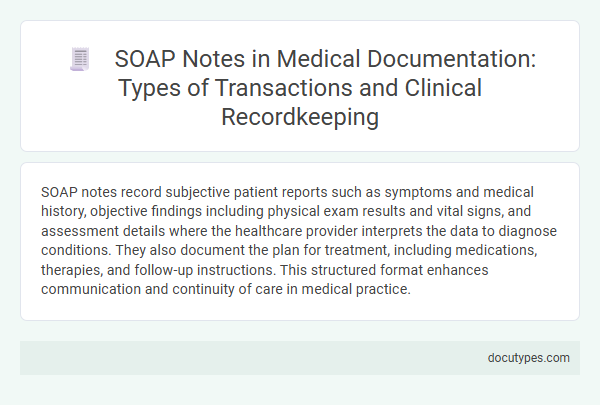SOAP notes record subjective patient reports such as symptoms and medical history, objective findings including physical exam results and vital signs, and assessment details where the healthcare provider interprets the data to diagnose conditions. They also document the plan for treatment, including medications, therapies, and follow-up instructions. This structured format enhances communication and continuity of care in medical practice.
Introduction to SOAP Notes in Medical Documentation
| Introduction to SOAP Notes in Medical Documentation |
|---|
| SOAP notes are a standardized method used by healthcare professionals to document patient encounters. The acronym SOAP stands for Subjective, Objective, Assessment, and Plan. These notes organize clinical data to improve communication among medical teams and enhance patient care. You record various types of transactions within each section to capture a comprehensive view of the patient's condition and treatment. |
| Types of Transactions Recorded on a SOAP Note |
|
Subjective: Patient-reported information such as symptoms, medical history, feelings, and concerns. This section captures your verbal communication with the patient, including descriptions of pain, duration, and intensity. Objective: Measurable and observable data collected during the clinical evaluation. This includes vital signs, physical examination results, laboratory tests, imaging findings, and other diagnostic information. Assessment: Clinical diagnosis or impressions based on the subjective and objective data. It reflects the healthcare provider's interpretation, including differential diagnoses and the patient's progress. Plan: The strategy for patient management, including treatment plans, prescribed medications, follow-up tests, referrals to specialists, and patient education. |
Components of SOAP Notes: Subjective, Objective, Assessment, Plan
SOAP notes record detailed transactions during medical consultations, capturing vital information about the patient's condition. These notes systematically organize data to enhance clinical communication and patient care.
The Subjective component documents the patient's reported symptoms and medical history, offering insight into their experience. Objective data includes observable and measurable findings such as vital signs and physical exam results. The Assessment provides a clinical diagnosis based on the subjective and objective information, guiding your medical decision-making.
Importance of Standardized Documentation in Healthcare
SOAP notes record clinical transactions including subjective patient reports, objective physical exam findings, assessments, and treatment plans. Each section captures distinct data critical for accurate diagnosis and continuity of care.
Standardized documentation in healthcare ensures consistency, improves communication among providers, and supports legal and billing requirements. This uniform approach enhances patient safety and facilitates clinical decision-making across multidisciplinary teams.
Types of Clinical Transactions in SOAP Notes
SOAP notes document various types of clinical transactions essential for patient care. Understanding the types of transactions recorded helps streamline your medical documentation process.
- Subjective Transactions - Records the patient's reported symptoms, concerns, and medical history as communicated during the encounter.
- Objective Transactions - Captures measurable data, including physical examination findings, vital signs, and diagnostic test results.
- Assessment Transactions - Summarizes clinical impressions, diagnoses, and evaluation based on subjective and objective data.
- Plan Transactions - Details the proposed treatment, medication prescriptions, follow-up instructions, and any referrals for continued care.
These clinical transactions ensure comprehensive and structured documentation in your SOAP notes.
Best Practices for SOAP Note Recordkeeping
What types of transactions are recorded on a SOAP note? SOAP notes document subjective patient information, objective clinical findings, assessment diagnoses, and planned interventions. Best practices for SOAP note recordkeeping emphasize clarity, accuracy, and completeness to ensure effective communication among healthcare providers.
Electronic Health Records (EHR) Integration with SOAP Notes
SOAP notes document patient encounters by recording subjective information, objective findings, assessments, and plans. In Electronic Health Records (EHR) systems, these notes facilitate seamless data entry, retrieval, and sharing among healthcare providers. Integration of SOAP notes with EHR enhances clinical decision-making and improves patient care coordination through structured and standardized transaction records.
Legal and Compliance Considerations in SOAP Documentation
SOAP notes document various clinical transactions crucial for patient care and legal compliance. Your accurate and detailed entries protect both patient rights and provider liabilities.
- Patient Encounter Details - Records of subjective complaints, objective findings, assessments, and plans form a comprehensive legal record.
- Informed Consent - Documentation of patient consent for treatments ensures regulatory compliance and reduces risk of litigation.
- Medication and Treatment Orders - Clearly recorded prescriptions and procedures support adherence to healthcare laws and auditing requirements.
Common Challenges in SOAP Note Creation
SOAP notes document essential clinical information, capturing Subjective, Objective, Assessment, and Plan data. Understanding common challenges in SOAP note creation enhances the accuracy and efficiency of medical record-keeping.
- Incomplete Subjective Data - Missing patient symptoms or history details can lead to gaps in clinical understanding and treatment planning.
- Inaccurate Objective Findings - Errors in recording vital signs, physical exam results, or lab data compromise diagnostic accuracy.
- Unclear Assessment and Plan - Vague or overly brief assessments and treatment plans reduce communication clarity among healthcare providers.
Enhancing Clinical Communication through Structured Notes
SOAP notes record key transactions including subjective patient reports, objective clinical findings, assessment of the condition, and planned interventions. Structured documentation streamlines clinical communication, ensuring accuracy and consistency across healthcare teams. You benefit from enhanced clarity and improved patient care through this standardized approach.
What Types of Transactions Are Recorded on a SOAP Note? Infographic

